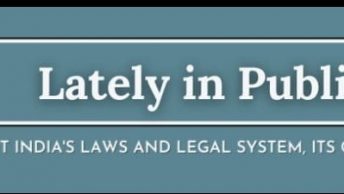The Delhi High Court delivered a landmark judgment in the case of Manushi Sangathan v. Govt. of Delhi earlier today. In this case, the constitutionality of some aspects of Delhi’s transport policy and its implementation was challenged. The following aspects were particularly at issue:
(i) The policy fixed the total number of cycle rickshaws that could ply on the streets of Delhi at 99,000;
(ii) It required that the plier of a cycle rickshaw must be its owner;
(iii) Cycle rickshaws which were plied without license were routinely confiscated and destroyed;
(iv) The policy imposed zoning restrictions where any particular rickshaw was licensed to ply only in certain zones;
(v) It did not provide any parking space for rickshaws; and
(vi) It did not provide for separate cycle lanes.
The judgment was written by Justice Ravindra Bhat, in which Chief Justice Shah and Justice Muralidhar joined. The Court held (i) and (ii) to be unconstitutional, (iii) to be unconstitutional and ultra vires the parent statute, upheld (iv) with a recommendation to MCD to reconsider zoning, directed that positive measures be taken to provide parking for cycle rickshaws, and issued a continuing mandamus to oversee the formulation of a fair road use policy. Some extracts follow:
On Article 14 (arbitrariness):
39. … In the present case, the rationale for the limit fixed by the impugned notification, i.e. 99,000 licenses, is not disclosed. There is no objective material to remotely justify imposition of such cap. On the other hand, there is ample material by way of relevant factors, disclosing that the authorities have been periodically reviewing the need for upward revision of such limits – in the past 50 years or so, at least on 4 occasions upward revision of such limit, has taken place. In the circumstances, it is held that the limit of 99,000 placed on the number of licenses which can be issued by the MCD is held to be arbitrary and hereby set aside.
42. … The MCD states that the [owner-plier] policy endeavours to minimize the exploitation of the rickshaw pullers by owners … the MCD has not placed on record any material or document evidencing consultation with such cycle rickshaw associations. There is no instance of exploitation of the rickshaw pullers cited by it on the basis of objective study or analyses based on any survey conducted etc.
47. … There is no empirical study made by any local agency on the impact of the existing policies under the bye-laws, either in regard to the cap of licenses or in regard to the inherent restrictions on the number of licenses flowing from the owner-puller policy.
On Article 14 (discrimination):
49. … there was really no answer to the petitioners‟ submission that rickshaw pliers are hostilely discriminated by the owner-plier policy, which condemns them to an impoverished existence. Neither the State agencies – including the police nor the intervenors were able to justify why the right of a plier to hire a rickshaw on rent for eking out his livelihood requires complete prohibition – barring the excepted category under the proviso to Bye-law 3(1).
66. … The figures of registered motor vehicles are in excess of 60 lakhs, as per the Govt. of NCT website; of these, as many as 38,55,055 are private cars (four wheelers) and only 45,817 buses ply on the city’s roads. As far as private commercial vehicles, catering to the commuter public are concerned, there are 76,090 TSRs (auto rickshaws) and 30,809 taxis (local, tourist, radio) on the road. Thus, there is a felt need for non-motorized road transportation, which the cycle rickshaws offer.
67. The respondents were unable to point out whether there is any restriction on the movement of such motorized private –especially private commercial vehicles, on arterial roads. The restrictions through the notifications issued by the Delhi Police, all pertain specifically to slow moving traffic. … The figures of number of vehicles and their impact on pollution levels in Delhi, as well as the dictates of the Delhi Master Plan are such that all agencies have to explore the optimum methods of minimizing environmental damage, and ensuring that best practices that protect the ecology are adopted. … Even if the cycle rickshaws are acknowledged to cater to short distance travel, the fact remains that the zoning regime presently in position, prohibits plying of cycle rickshaws of one zone in another. This can lead to practical problems … Such restrictions can affect poor commuters and travelers the hardest, particularly if they have to commute from inter state bus termini, railway stations, etc., with heavy luggage. … However, this Court would not hold that such zoning restrictions, or ban on the use of arterial roads, by cycle rickshaws, invalid, because the number of such vehicles that would become available as a result of removal of the cap, and their use by classes of pliers, other than owners, is unknown. Also, there is lack of empirical data about road usage and scientific basis for concluding one way or the other that placing such restrictions do not impede smooth movement of traffic, particularly on main and arterial roads. This Court therefore, does not hold that such restrictions are void or discriminatory, but would require the authorities to study all the relevant factors, and take such remedial measures as are necessary in the light of the previous discussion.
69. … If clear spaces are not earmarked for rickshaw parking, the pliers would be forced to park them at the place most convenient to him; usually on some stretch of the main road. This can lead to unhappy and undesirable situations, where the rickshaw plier’s livelihood is threatened on a daily basis, as the possibility of rickshaws being damaged, or taken away looms large. Besides, such a position would always expose the rickshaw plier to threat from the police and municipal authorities, who can object to the practice, saying that public roads or public property cannot be utilized for parking cycle rickshaws. … It cannot also be lost sight of that there is no requirement that other class of vehicle owners must possess any such parking space. Bus, trucks and car owners are not subjected to any such condition. Imposing such restrictions on rickshaw pliers and owners is therefore, discriminatory….the MCD should endeavor, as part of their obligation, to
provide safe park and ride lots.
On Article 19(1)(g):
50. It has been recognized that the State power extends to complete prohibition of a commercial activity in the legitimate exercise of imposing reasonable restrictions under Article 19(6). The law declared by the Supreme Court in these last fifty years speaks uniformly in that- it is the rights, which are fundamental and not the restrictions and that any legislative or executive measure that has the effect of totally prohibiting an individual from exercising his freedom to trade and carry-on any profession under Article 19(1)(g) should be imposed in rare and exceptional circumstances…
51. … a greater latitude is permitted to the State in regulating what are considered inherently dangerous activities or those which might pose a threat to the general public, as, for instance, liquor trade, trade and commerce in fire arms and explosives; drug trade and activity that could be harmful or injurious to the environment generally, such as commerce in animal skins and products, ivory etc. However, outside of such exceptional categories, a total prohibition of the right to carry-on business, is generally regarded as an unreasonable restriction
On Article 300A (the Right to Property):
60. The right to property, although no longer a fundamental right, is still a human right and a constitutional right guaranteed under article 300A of the Constitution of India, which provides that “no person shall be deprived of his property save by authority of law.”
62. In the present case, there are specific provisions in the Act, authorizing the MCD to exercise confiscation and seizure powers … Section 158 (8) even prescribes that in the event of disposal of such property, seized or distrained, for recovery of specified municipal dues, if some surplus remains, the property owner is entitled to such amount. … There is no such power to seize, confiscate and destroy cycle rickshaws. Therefore, the bye-laws, and impugned resolutions, to the extent they authorize the exercise of such power are arbitrary as well as ultra vires (the parent Act).
63. … With this Court declaring clauses 4(k) and (l) of the policy and bye-laws 17(b), and 17A to be unconstitutional, there is no power in the MCD, much less the Delhi Police, to seize and either sell in auction or destroy a rickshaw even where it is found to be driven without a licence or by a person not having a proper licence. We are not unmindful of the manner in which these wide powers were being exercised with cycle rickshaws being easy targets for unleashing the lathi of a traffic policeman. It is hoped that the Delhi Police will, consistent with this judgment, instruct its personnel to treat rickshaw pullers with sensitivity.
On Transport policy:
71. … Road space cannot be appropriated or monopolized by one mode of transport, particularly when the bulk of the population depends on public transport. The various figures discussed in the earlier portion of the judgment would reveal that there is a crying and urgent need to increase and augment public transport – be it increase in the number of buses, the Delhi Metro or any other mode. Also, the respondents have to consider all options, including imposing stringent restrictions on the use and movement of private cars, in certain congested areas of the City, and also limit their use.
72. … road management cannot mean prioritization of access to only one class of vehicles, particularly when there is a significant body of evidence that such class contributes to clogging of roads. Though public transport users apparently contribute the bulk of the city’s commuters (i.e. buses travel 210 kms. each day, on an average, in Delhi- which, if it means three round trips, translates on an average to use of about 22,000 (out of 45,000 odd registered buses) by 600 persons, which in turn works out to one crore commuter trips. However, the 32 lakh odd cars – even if the usage is 60% each day, by two persons, would result in fewer trips. The propensity of those cars however, is to appropriate a lion‟s share of the road space available in Delhi.
On Separation of Powers and appropriate role of Courts:
73. We are of the opinion, in view of the above discussion, that even while not disturbing the zoning restrictions and the ban (on cycle rickshaws in arterial roads) this is a fit case where the authorities should explore all options to reduce road congestion, and consider all proposals, from an overall, or holistic perspective. These proceedings are in the nature of public litigation. The Supreme Court has stressed the need for courts to adopt new approaches and innovate, while dealing with such public issues, when moulding the relief, in a given case. One such relief is “continuing mandamus” – an innovation first commented upon in Vineet Narain v. Union of India, 1998 (1) SCC 226. While adopting such a course, the courts issue declaratory judgments and at the same time, having regard to the subject matter, give operative directions, which also ensure oversight that guides implementation of its orders. In the circumstances of this case, we are of the opinion that these cases are instances where such continuing mandamus has to be issued.
On dignity of work:
35. …this Court concludes that the assumption in Hemraj that the cycle rickshaw plying by individuals or citizens offends human dignity and perhaps requires to be eliminated or drastically controlled, is contrary to the freedom guaranteed under Article 19(1)(g).
On the importance of context:
54. One established principle of Constitutional law is that a legislation or regulation if once held valid, can be successfully challenged if there is a significant change in circumstances.






Does anyone know who counsel for the State was?
amazing judgment. i was there in court when it was dilevered. the bench headed by justice shah, manushi led by ms. madhu kishwar, prashant bhushan for being the counsel, and inidra unninayar who drafted the petition deserve kudos.
this is a rare judgment where the court has expanded the rights and freedom of the poor. it is as historic, if not more, than the section 377 ipc judgment dileverd by the same bench (minus justice bhat) or the rti judgment of the full bench led by chief justice shah. such judgments should have been the natural result of constitutional pronouncements by our courts, have become rare as the courts become more and more elitist.
this also focuses our attention to what a judge justice shah has proved to be. and why didn't the collegium elevate him?
According to court corridor gossip, Justice AP Shah had some serious personal differences with some members of the present collegium of judges which resulted in his elevation being held up.
He will join the long list of excellent judges who never made it to the Supreme Court of India but whose contribution to India's polity must nonetheless not be forgotten.
You are quite right Alok. It was in fact Justice Kapadia (our next CJI) who was totally opposed to Justice Shah's elevation to SC. Collegium has become give and take. If 5 judges are to be elevated, then each Member of the collegium picks one judge. Since everything is behind close doors, so it has become highly nepotistic. Attempts to promote transparency have been stonewalled by SC itself. (SC has stayed the CIC judgment asking for information as to why were judges like Justice Shah superseeded). This has also resulted in making HC judges subservient to the collegium judges (since they want to come to SC and also get 3 more years before they retire).
Anyway, Justice Shah's non elevation came as a boon to Delhi High Court lawyers, PIL lawyers like Mr. Bhushan (he filed virtually every PIL in DHC in 2008-10 instead of SC as was his earlier practice) and to the Delhi High Court itself. DHC is today one of the finest high courts in the country today in terms of being less corrupt, good jurisprudence and more technology-friendly.
We now look forward to seeing Justice Shah practice as an advocate in the SC.